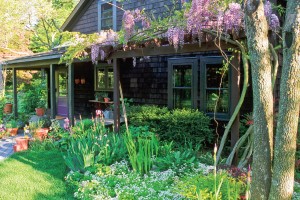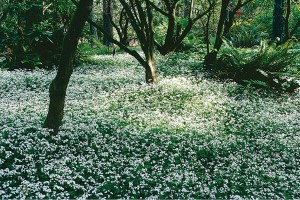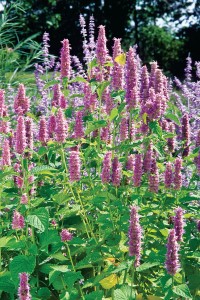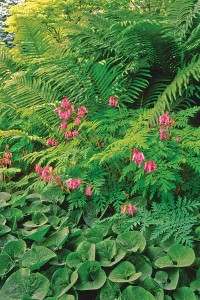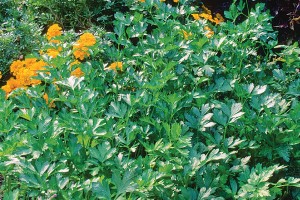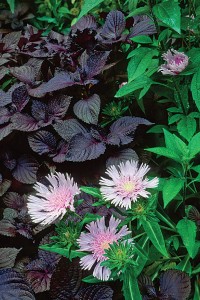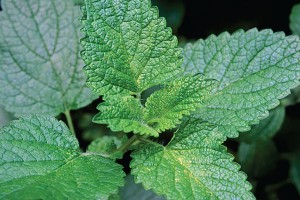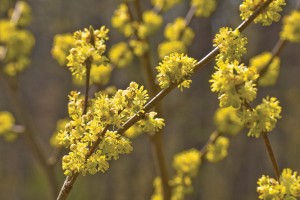Wondering what to plant in those shady areas of your landscape? There’s no need to resign yourself to standard shade-fillers, like pachysandra and ivy, when you could be growing useful herbs that thrive in low-light conditions. While many culinary herbs do require lots of direct sunlight (like basil and oregano, which originated in the sunny Mediterranean), other herbs usually listed as full-sun plants will do just fine in partial shade. Parsley, anise hyssop, lemon balm and shiso are among the best herbs for dappled light or areas that receive only a couple of hours of direct sun daily.
Other, less-familiar herbs actually prefer shade. In nature, these plants can be found growing in the dappled light below trees, or at the edges of forests, where the sun shines directly on them for only a short time each day. These plants—which include wild ginger, spicebush and sweet woodruff—will do beautifully in a shady garden site, and will add enticing new flavors and aromas to your cooking.
For beds and borders shaded by trees, fences or buildings, try one or more of these seven stars for shade.
1. Sweet woodruff
2. Anise hyssop
3. Wild ginger
4. Parsley
5. Shiso
6. Lemon balm
7. Spicebush
Sweet Woodruff
A wonderful groundcover, this European native bears lacy, white flowers in late spring. A naturally moist or irrigated site is best. Both leaves and flowers have a fresh scent and make a delicately sweet tea. In Germany, the flowering tops are traditionally used to make May wine. To make your own May wine, steep flowers in Riesling wine overnight, strain out the woodruff, and add strawberries. Serve chilled.
Avoid consuming sweet woodruff if you have circulatory problems or if you are pregnant.
Anise Hyssop
Many culinary and medicinal herbs thrive in partial or full shade. Although gardening guides continue to list anise hyssop (shown this page) as suitable for “full sun only,” this native American perennial will bloom and thrive in partial shade. Both the flowers and leaves have an intense licorice aroma and flavor. Fresh or dried, the herb makes a delicious tea that pairs well with baked goods like scones, muffins and biscotti. Dried anise hyssop leaves also can be used in place of anise seeds to flavor cookies.
Anise hyssop has a long history of medicinal use by Native Americans. The Cheyenne used anise hyssop tea to relieve depression, while the Cree and Chippewa included it in protective medicine bundles.
Wild Ginger
An attractive groundcover with heart-shaped leaves, wild ginger also can be used to flavor both sweet and savory dishes. To harvest wild ginger without destroying the perennial, dig about 2 inches into the soil between the plants. Snip off a few inches of the rhizomes, then pat down the soil. You can harvest in this fashion several times a year without decimating your beautiful patch of wild ginger.
Parsley
This Mediterranean biennial has been cultivated since at least the 3rd century b.c. Choose flat-leaf parsley (Petroselinum crispum var. neapolitanum; shown at right) for flavor and curly parsley (P. crispum) for garnishes. In addition to using the leaves in almost any savory dish, you can use the chopped roots—which taste like a cross between parsnips and carrots—in soups and stews.
The plant is quite cold-hardy and can be harvested even when temperatures hover around freezing.
Shiso
Shiso (Perilla frutescens; annual), also called beefsteak plant, has three leaf color variations (purple, green and a bicolor), all of which are as ornamental as they are tasty. Shiso self-seeds readily in the garden, but because of its shallow root system, it’s easy to weed out.
In Japan, purple shiso (shown above) is used to color the pickled ginger served with sashimi. Shiso’s versatile flavor, a combination of cilantro and mint with spicy overtones, is as good with fresh fruit as it is with savory seafood and rice dishes.
Shiso Salad
Serves 4
• 2 cucumbers, peeled and sliced
• 2 tablespoons seasoned rice vinegar
• 1 large peach, peeled and chopped
• ¼ cup green or purple shiso, chopped
• Pinch of salt
1. Combine cucumbers and vinegar; let stand at room temperature 10 minutes.
2. Add peach, shiso and salt. Toss to combine.
Lemon Balm
Lemon Balm is a European perennial that does as well in shade as it does in full sun. Its delightful lemon scent comes from its high essential oil content. The leaves are best harvested in mid-spring. As a culinary herb, lemon balm makes a delicious tea and the minced leaves are a nice addition to fruit salads. Essential oil of lemon balm is used in aromatherapy as an antidepressant. The herb loses its potency when dried, but the fresh herb can be tinctured to preserve its medicinal properties.
In the garden, lemon balm can be invasive. Prune off the flowering tops before they go to seed.
Lemon Balm Butter Sauce
Serves 4 to 6
• 2 tablespoons fresh lemon balm leaves, minced
• 1⁄4 cup butter, melted
• Salt, to taste
1. Add lemon balm to melted butter.
2. Wait 30 seconds, then toss with cooked vegetables.
Spicebush
Sometimes called northern spicebush, is a lovely, native American woodland shrub that thrives in partial shade, such as it would have at the edge of a forest clearing. Spicebush grows to 10 feet tall, with pretty, teardrop-shaped leaves 2 to 5 inches long.
The entire plant is aromatic. The female plants produce fragrant yellow flowers in early spring, followed by small, bright-red oval fruit in autumn. (Because spicebush is dioecious, both male and female plants are needed for fruit production; check with your supplier to be sure you are getting both if you wish to obtain the berries.)
Use the fresh leaves in hot or iced tea; they do not retain their flavor well when dried. The twigs can be simmered in water for a warming tea any time of year.
In the fall, collect the red berries and dry them to use as a spice that has both sweet and savory uses. Sometimes sold as “Appalachian allspice,” spicebush can be used like allspice and makes a scrumptious ice cream and spice cake. The berries have a peppery note that makes them an excellent addition to meat rubs and marinades, as well.
The Ojibwa and Iroquois tribes treated spicebush berries as two different seasonings. They separated the seeds from the surrounding pulp and red skins. The pulp and skins were used for their sweet, allspice-like taste and the seeds for their peppery bite. If you want to separate the berries into two different spices, do so before drying or freezing as they are almost impossible to separate after preserving. Separated or whole, the berries have a high fatty oil content and can go rancid if stored at room temperature. Store both fresh and dried spicebush in the freezer. To use, grind in an electric coffee grinder. Note: Take care not to confuse Lindera benzoin with another native American shrub, Calycanthus floridus, commonly called “Carolina allspice” and also sometimes called “spicebush.”
Original Article:http://www.motherearthliving.com/gardening/7-herbs-that-grow-in-shade.aspx




